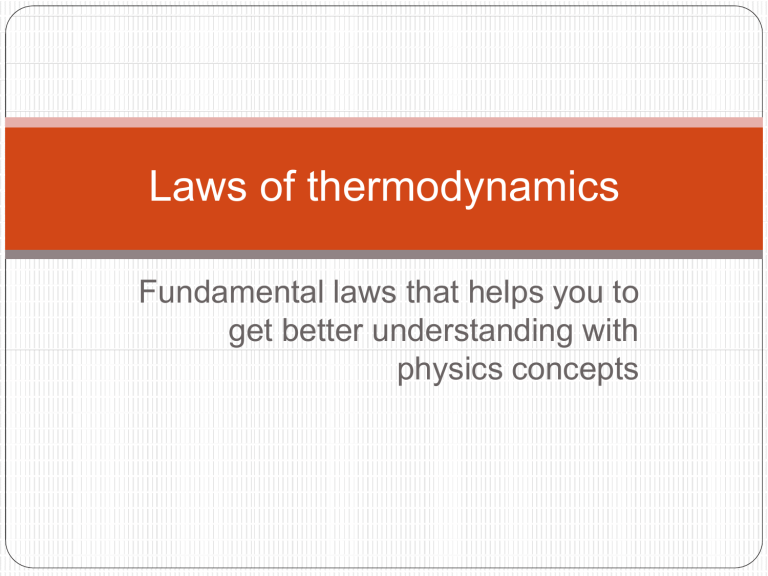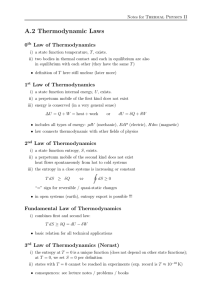Laws of Thermodynamics: Fundamental Physics Concepts
advertisement

Laws of thermodynamics Fundamental laws that helps you to get better understanding with physics concepts We have four laws of thermodynamics, which define fundamental physical quantities i.e., temperature, energy, and entropy that characterize thermodynamic systems and their behaviour under various circumstances. They are 1. Zeroth law of thermodynamics 2. First law of thermodynamics 3. Second law of thermodynamics 4. Third law of thermodynamics Zeroth law of thermodynamics • If two systems are in thermal equilibrium with a third system, they must be in thermal equilibrium with each other. • This law describes an empirical parameter, the temperature, as a property of a system such that systems in thermal equilibrium with each other have the same temperature. First law of thermodynamics • The increase in internal energy of a closed system is equal to the heat supplied to the system minus work done by it. • First law of thermodynamics is also known as the law of conservation of energy. • This states that energy can be neither created nor destroyed. However, energy can change forms, and energy can flow from one place to another. The total energy of an isolated system does not change. • dUsystem=Q - W First Law includes several principles • The law of conservation of energy. • The concept of internal energy and its relationship to temperature. • The flow of heat is a form of energy transfer. • Work is a process of transferring energy to or from a system. Combining these principles leads to one traditional statement of the first law of thermodynamics: It is not possible to construct a machine which will perpetually output work without an equal amount of energy input to that machine. Or more briefly, a perpetual motion machine is impossible. Second law of thermodynamics • The entropy of any isolated system almost never decreases. Such systems spontaneously evolve towards thermodynamic equilibrium that is the state of maximum entropy of the system. Equivalently, perpetual motion machines of the second kind are impossible. • According to this law, in a reversible heat transfer, an element of heat transferred, δQ, is the product of the temperature (T) and its entropy (S) • dQ = TdS The 2nd Law can also be stated that heat flows spontaneously from a hot object to a cold object (spontaneously means without the assistance of external work) Third law of thermodynamics • The entropy of a system approaches a constant value as the temperature approaches absolute zero. • At zero temperature the system must be in a state with the minimum thermal energy. This statement holds true if the perfect crystal has only one state with minimum energy. Entropy is related to the number of possible microstates according to: S = kBln Ω Where S is the entropy of the system, kB Boltzmann's constant, and Ω the number of microstates At absolute zero there is only 1 microstate possible (Ω=1 as all the atoms are identical for a pure substance and as a result all orders are identical as there is only one combination) and ln(1) = 0. • A more general form of the third law that applies to a systems such as a glass that may have more than one minimum microscopically distinct energy state, or may have a microscopically distinct state that is "frozen in" though not a strictly minimum energy state and not strictly speaking a state of thermodynamic equilibrium, at absolute zero temperature: • The entropy of a system approaches a constant value as the temperature approaches zero. • The constant value (not necessarily zero) is called the residual entropy of the system. Thank You






